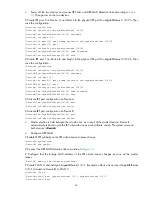
34
[DeviceA] interface ten-gigabitethernet 1/0/25
[DeviceA-Ten-GigabitEthernet1/0/25] shutdown
[DeviceA] irf-port 1/2
[DeviceA-irf-port1/2] port group interface ten-gigabitethernet 1/0/25
[DeviceA-irf-port1/2] quit
[DeviceA] interface ten-gigabitethernet 1/0/25
[DeviceA-Ten-GigabitEthernet1/0/25] undo shutdown
[DeviceA-Ten-GigabitEthernet1/0/25] save
# Create IRF port 1 on Device B, and bind it to the physical IRF port Ten-GigabitEthernet 2/0/26. Then
save the configuration.
<DeviceB> system-view
[DeviceB] interface ten-gigabitethernet 2/0/26
[DeviceB-Ten-GigabitEthernet2/0/26] shutdown
[DeviceB] irf-port 2/1
[DeviceB-irf-port2/1] port group interface ten-gigabitethernet 2/0/26
[DeviceB-irf-port2/1] quit
[DeviceB] interface ten-gigabitethernet 2/0/26
[DeviceB-Ten-GigabitEthernet2/0/26] undo shutdown
[DeviceB-Ten-GigabitEthernet2/0/26] save
# Activate IRF port configuration on Device A.
[DeviceA-Ten-GigabitEthernet1/0/25] quit
[DeviceA] irf-port-configuration active
# Activate IRF port configuration on Device B.
[DeviceB-Ten-GigabitEthernet2/0/26] quit
[DeviceB] irf-port-configuration active
3.
Master election is held between the two devices. As a result of the master election, Device B
automatically reboots to join the IRF virtual device as a subordinate switch. The system name on
both devices is
DevcieA
.
4.
Configure BFD MAD detection
# Create VLAN 3, and add port GigabitEthernet 1/0/1 on Device A (with the member ID of 1) and port
GigabitEthernet 2/0/1 on Device B (with the member ID of 2) to VLAN 3.
<DeviceA> system-view
[DeviceA] vlan 3
[DeviceA-vlan3] port gigabitethernet 1/0/1 gigabitethernet 2/0/1
[DeviceA-vlan3] quit
# Create VLAN-interface 3 and configure the MAD IP address for the interface.
[DeviceA] interface vlan-interface 3
[DeviceA-Vlan-interface3] mad bfd enable
[DeviceA-Vlan-interface3] mad ip address 192.168.2.1 24 member 1
[DeviceA-Vlan-interface3] mad ip address 192.168.2.2 24 member 2
[DeviceA-Vlan-interface3] quit









































